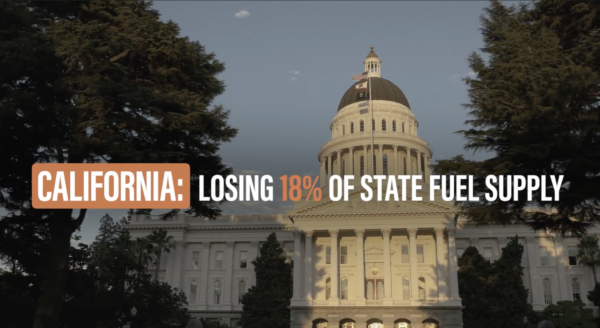Much like radical activists, Rep. Ro Khanna pushed rhetorical illusion while providing zero evidence for false and unproven claims.
Here are four ways Khanna’s radical talking points got it wrong:
1. Khanna’s Fantasy: “It’s time for California to stop building new fossil fuel projects … no new oil drilling, no new pipelines and no new refineries.”
California’s Reality: Keeping more of California’s energy resources in the ground won’t lower our demand for oil. California consumes 1.8 million barrels of oil a day to fuel transportation, power businesses, grow food, and produce thousands of consumer products. Just 26% of that total is produced in-state, and demand is only increasing. Shutting down in-state production would not end the California economy’s huge need for energy. Rather, it would only result in more oil being imported from foreign sources on tanker ships and railways, impacting affordability, reliability, and safety.
As Governor Brown put it in 2015: “As we speak [Californians] are burning up gasoline that is being shipped from Iraq, from Russia, from Venezuela and all sorts of other places … so whatever we don’t do here we are going to get from somewhere else.”
2. Khanna’s Fantasy: “Newsom should institute a 2,500-foot buffer zone” to “ensure that not one more person must bear the health burden of the oil and gas industry’s pollution in their backyard or schoolyard.”
California’s Reality: As indicated by Khanna citing zero evidence for this claim, studies reject the idea that oil and gas facilities cause adverse health effects. For example, the Los Angeles Department of Public Health (LADPH) has thoroughly reviewed this question, evaluating seven Environmental Impact Reports and two Health Impact Assessments of oil and gas production sites in a recent comprehensive report. A technical analysis of these assessments found no evidence of significant adverse public health impacts or risks. In fact, one study included in the LADPH report found that doing away with oil and gas operations would have no appreciable effect on public health.
In addition, Community Health Assessments of the Inglewood Oil Field in 2011 and 2015 confirmed that the health outcomes of residents near the field to be similar to (and often better than) the health of residents throughout Los Angeles County and in areas where no oil production occurs. In another study – the South Coast Air Quality Management District’s assessment of oil and gas operations presented to the Stationary Source Board found that toxins and particulate matter were “similar to levels observed in typical ambient air” and “below short-term exposure health guidance levels.”
In short, Khanna is perpetrating a myth by pushing the narrative that oil and gas operations cause negative health impacts. More than two dozen local, regional, state and federal agencies regulate every step of the production process in California to ensure public health and environmental protections. California oil and gas is produced under the most stringent emission control regulations in the world.
3. Khanna’s Fantasy: Newsom can “jump start a clean energy revolution that will create thousands of good-paying jobs” while providing “justice for industry workers and their communities” to “ensure the clean energy revolution leaves no one behind.”
California’s Reality: While activists like to talk about “just transitions” for workers and communities, the facts don’t shake out – and workers aren’t buying it. According an analysis by Capitol Matrix Consulting, the oil and gas industry supports 55,000 jobs in California, and experts often point out that “transitioning” workers isn’t as straightforward as it sounds.
Brian Murray, the Director of the Duke University Energy Institute, recently wrote in Forbes:
In theory, new renewables jobs could be filled by workers exiting the fossil fuel industry. But the need for rapid transferability of skills and interregional migration of labor presents challenges. Field electricians, for instance, may find it easy to re-apply their skills from an oil field to a wind farm, but how easily can a derrick worker become a solar panel installer or an underground miner become a wind turbine service technician? What type of retraining would be necessary for such transitions, how long would it take, and what would wage differentials across occupations look like?
Neither radical activists nor Rep. Khanna have any answers for Murray’s questions. And, furthermore, recent economic analysis shows the “just transition” is little more than a talking point. One analysis by Capitol Matrix Consulting found that jobs in the renewable energy sector pay significantly less than oil and gas production industry jobs. The average wage for “green” jobs was found to be $66,000 per year, which is 42% lower than the average oil and gas production job ($113,000). In addition, the average “green” job pays 33% less than the average oil and gas pipeline and construction sector job ($99,000).
These facts have led workers and labor leaders to question the veracity of “transition” promises. As Robbie Hunter, president of the California Building and Construction Trades Council recently told Politico: “All it does is do what the Democratic Party seems to be very good at lately — which is export our jobs, while doing nothing for the end game, which is the environmental.’’
4. Khanna’s Fantasy: California has an “addiction” to oil and natural gas.
California’s Reality: Oil and natural gas are versatile resources central to our quality of life. They provide reliable, affordable sources of energy and raw materials that are currently essential for Californians to grow and deliver food, heat homes, fuel transportation, power businesses, and create thousands of products that make our lives better.
Local oil and gas production is necessary for carbon neutrality. Khanna ignores the versatility of petroleum far beyond its role as the preeminent fuel source. Petroleum compensates for the intermittency of renewable energy and serves a critical role in building materials, medical devices, zero-emission vehicles and renewable energy components and thousands of products essential to modern society.
By pushing false and unproven claims as part of a radical narrative against the oil and gas industry, Rep. Khanna is doing Californians a disservice. Voters and policymakers deserve an energy future grounded in science and facts, not rhetorical fantasy.
Khanna’s hardline “keep it in the ground” position is directly at odds with energy policy experts who say a broad mix of energy sources will be necessary to reliably power the future while drastically lowering emissions. For instance, the California Council on Science and Technology’s comprehensive review of the state’s energy future concluded that even with “rapid and aggressive” deployment of renewable energy, oil and natural gas will still be “imperative” for several purposes and sectors of the economy beyond 2050. Similarly, the U.S. Energy Information Administration’s 2019 Annual Energy Outlook found that traditional sources like oil and natural gas will still provide a large majority of the country’s total energy needs in 2050.
The California oil and gas industry is working toward a new energy future, collaborating with renewable developers to invest in new technologies, resulting in lower carbon intensity and lower costs for consumers. The industry recognizes that both traditional and renewable energy sources are vital to our future.
We invite Rep. Khanna to join that reality.


